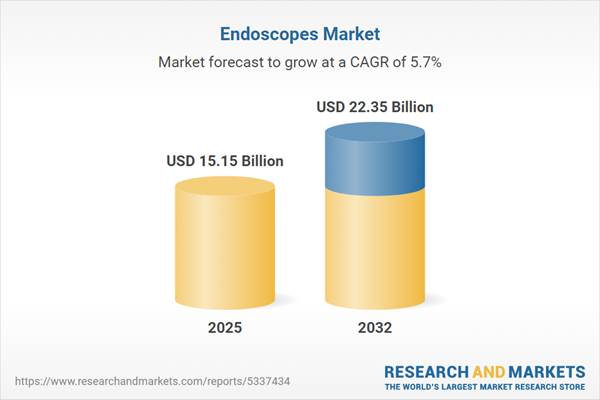Speak directly to the analyst to clarify any post sales queries you may have.
The global endoscopes market is entering a period of pronounced transformation. Senior executives must navigate a landscape shaped by disruptive medical technologies, evolving clinical expectations, and increasingly complex regulatory environments. Success depends on the ability to align innovation, operational efficiency, and patient safety across the healthcare spectrum.
Endoscopes Market Snapshot
In 2024, the global endoscopes market achieved a valuation of USD 14.33 billion, projected to reach USD 15.15 billion in 2025, and nearly USD 22.35 billion by 2032. This sustained growth, highlighted by a compound annual growth rate of 5.71%, is underpinned by rapid adoption in hospitals, clinics, and ambulatory care centers. Advances in digital imaging and expanded workflow integration are catalyzing change, enabling integrated endoscopy solutions to enhance procedural outcomes and support collaborative, multidisciplinary care. Increasingly, capital allocations are directed toward workflow-driven platforms, where the deployment of advanced technologies contributes not only to higher efficacy but also to improved patient experiences and team-based healthcare delivery.
Scope & Segmentation of the Global Endoscopes Market
This report provides in-depth guidance tailored to assist procurement leaders and senior decision-makers with their strategic choices on technology selection, product positioning, and market entry. Comprehensive segmentation ensures clarity for both investment allocation and operational execution:
- Product Types: Capsule endoscopes facilitate enhanced diagnostic reach across the gastrointestinal tract. Flexible endoscopes are integral in gastroenterology and pulmonology, while rigid variants support advanced surgery. Single-use devices are increasingly important for infection prevention.
- Applications: Arthroscopes are essential for musculoskeletal interventions. Endoscopy supports minimally invasive treatments in gastrointestinal, gynecological, and urological specialties, a trend reflecting the preference for minimal access techniques worldwide.
- End Users: Hospitals, clinics, ambulatory centers, and diagnostic facilities deploy sophisticated platforms to achieve greater procedural precision and streamline operations, responding to new care models and changing patient needs.
- Technology Platforms: Digital imaging, video, fiber optic, and wireless capsule systems enable connectivity, integration with telemedicine, and support for remote diagnostics, broadening the utility of endoscopy for both routine and specialized procedures.
- Usage Modes: Both reusable and single-use endoscopes contribute to infection control and operational flexibility, supporting compliance with a range of regional regulatory requirements.
- Regions Covered: The Americas, Europe, Middle East, Africa, and Asia-Pacific display distinct adoption drivers and legal frameworks, influencing the pace of uptake and guiding regional investment strategies.
- Key Players Analyzed: Key industry influencers such as Olympus Corporation, FUJIFILM Holdings Corporation, HOYA Corporation, Karl Storz SE & Co. KG, Stryker Corporation, Boston Scientific Corporation, Medtronic plc, Cook Medical LLC, Richard Wolf GmbH, and CONMED Corporation drive innovation, market structure, and competition.
Key Takeaways for Senior Decision-Makers
- Adoption of digital imaging and capsule endoscopy is accelerating, equipping clinicians to intervene earlier and ensuring consistent patient care across varied healthcare environments.
- There is sustained momentum toward minimally invasive procedures, reinforcing the demand for precise, durable platforms that improve workflow and clinical outcomes.
- Single-use endoscopes are increasingly implemented to strengthen infection control and simplify compliance with global health and safety mandates in regulated environments.
- Regional and global supply chains are adapting to shifting regulatory and economic conditions; building diversified sourcing models helps organizations mitigate logistical risks and maintain device availability.
- Artificial intelligence integration with endoscopy platforms is advancing resource allocation, improving diagnostic reliability, and supporting team-based patient management strategies.
Tariff Impact on the Endoscopes Market
Recent modifications to U.S. import tariffs have prompted larger healthcare providers to prioritize domestic and regional supply networks, particularly across North America and Mexico. While these changes offer stability in device sourcing for major buyers, smaller organizations may need to revisit procurement and financial planning to address potential pricing volatility and evolving trade requirements.
Methodology & Data Sources
This analysis draws from direct interviews with clinical leaders, procurement specialists, and industry experts, integrating validated regulatory assessments and proprietary market data. The combined approach ensures relevance and practical utility for stakeholders guiding procurement, investment, and operational initiatives within the endoscopes value chain.
Why This Report Matters for B2B Market Leaders
- Presents actionable intelligence and peer benchmarking to refine competitive strategy, supporting leaders managing rapid change in the medical device sector.
- Clarifies the operational and regulatory implications of current technology trends, enabling leaders to deploy agile, forward-looking procurement and supply chain frameworks.
- Highlights risk factors for executive teams, helping anticipate and address vulnerabilities while sustaining business continuity as global and regional markets evolve.
Conclusion
Leveraging these strategic insights enables executives to proactively address regulatory shifts, optimize capital deployment, and strengthen organizational resilience as the global endoscopes market continues its evolution.
Additional Product Information:
- Purchase of this report includes 1 year online access with quarterly updates.
- This report can be updated on request. Please contact our Customer Experience team using the Ask a Question widget on our website.
Table of Contents
3. Executive Summary
4. Market Overview
7. Cumulative Impact of Artificial Intelligence 2025
Companies Mentioned
The companies profiled in this Endoscopes market report include:- Olympus Corporation
- FUJIFILM Holdings Corporation
- HOYA Corporation
- Karl Storz SE & Co. KG
- Stryker Corporation
- Boston Scientific Corporation
- Medtronic plc
- Cook Medical LLC
- Richard Wolf GmbH
- CONMED Corporation
Table Information
| Report Attribute | Details |
|---|---|
| No. of Pages | 186 |
| Published | October 2025 |
| Forecast Period | 2025 - 2032 |
| Estimated Market Value ( USD | $ 15.15 Billion |
| Forecasted Market Value ( USD | $ 22.35 Billion |
| Compound Annual Growth Rate | 5.7% |
| Regions Covered | Global |
| No. of Companies Mentioned | 11 |









